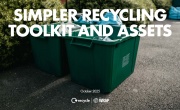Why we need to competitively price secondary plastics
Otto de Bont, CEO of Renewi, argues that the UK Government needs to learn from its continental neighbours and do more to support use of secondary resources rather than virgin materials.
Boris Johnson recently called for the upcoming UN Climate Change Conference in Glasgow (COP26) to be a “turning point for humanity”; a rallying cry that was echoed by many of us in the sustainability industry. One area to focus on is waste and recycling, where - according to the Circularity Gap report produced by Think-tank Circle Economy - the establishment of a circular economy would reduce carbon emissions by 39 per cent.
Last year’s report found that, of more than 100 billion tonnes of extracted materials used to manufacture goods (the highest ever recorded), less than 9% of materials were recycled or made into secondary raw materials. The carbon footprint of extracted (primary) raw materials is significantly higher than that of secondary materials.
The Prime Minister’s government has introduced some legislation to enable the circular economy, including the Circular Economy Package (CEP) established in 2020, which built on the existing Resources and Waste Strategy (RWS) created in 2018. This introduced a revised legislative framework, identifying steps for reducing waste and establishing an ambitious and credible long-term path for waste management and recycling. Whilst these steps highlight the need for a circular economy and demonstrate how the UK government might get there, they are not the same as the tangible regulatory changes that are needed to achieve a more circular economy. The UK Government must now create the incentives required for a truly circular economy.
Rather than trying to build this new circular economy from scratch, UK regulators should look to international peers who are already doing this well. According to the European Environmental Agency, Belgium is ranked fifth in the European Union for municipal waste recycling with 55% per cent of municipal waste being recycled. One driver of this is their regulatory environments, which incentivise the use of secondary (recycled) materials by making them economically competitive in comparison to virgin materials.
In the case of plastics, the UK will be bringing in a £200 fee per tonne of non-recycled plastic packaging next year, on par with Ireland’s tax of €271, set to come into play in 2023. While this looks like progress, it is a fraction of the taxes levied by European country leaders such as Belgium (€996), Austria (€685), and Spain (€856), where yet further increases are being considered for the coming years. The impact of such a disparity in fees is obvious.
A report from S&P Global Platts, a commodity market specialist, revealed that recycled plastic now costs an extra $72 (£57) per tonne compared with newly made plastic. This, combined with the fact that secondary materials typically struggle to achieve the same level of quality as virgin production, means that UK businesses currently have little to no incentive to use secondary materials, despite the environmental benefit. Government has an opportunity to address this imbalance with a more strategic approach to taxation.
Getting to circularity also requires that we address the issue of secondary material quality. Recycled materials pose a challenge when incorporated into production lines that work to precise and narrow input requirements. While innovation is improving the quality of secondary raw materials, product designers and manufacturers must also be encouraged to broaden their design specifications to better integrate these materials into their production process. A circular economy requires the support and input of producers, consumers, regulators and waste companies and - once again - the UK government needs to drive these changes. This should include regulating the quality of recycled materials and introducing minimum quotas for the inclusion of secondary materials by product manufacturers.
Circularity is an important step up - not only to help us meet the targets set within the Paris Agreement for reduced emissions, but also to go beyond this. To do this, we need to slow down the extraction of primary raw materials and give new life to the creation of high-quality secondary raw materials. This will put the UK on the frontline of circular development and at the heart of the battle against climate change. Pricing virgin raw materials based on their full environmental cost, similar to best practice international standards, would allow the implicit value of secondary raw materials to be realised. It would boost use and contribute to the targeted doubling of circularity which in turn would drastically reduce plastic waste and carbon emissions.
On the surface, the UK’s approach to a circular economy appears to tick all the right boxes. But it falls short of specific regulatory changes that are needed to drive the inclusion of secondary materials into the production process. The government has plenty of international examples to draw on when it comes to effective regulation and its potential to impact the circular economy. If Boris Johnson is serious about making significant changes in the wake of COP26, he needs to get serious about significant regulatory change. 






